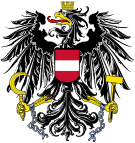Parliamentary elections were held in Austria on 10 May 1959.[ 1] Socialist Party (SPÖ) received the most votes, the Austrian People's Party won one more seat than the SPÖ. The Communist Party of Austria lost its remaining three seats and has not returned to the National Council since. Voter turnout was 94%.[ 2] [ 3] Julius Raab as chancellor and Socialist leader Bruno Pittermann as vice-chancellor .[ 4]
Results Party Votes % Seats +/– Socialist Party of Austria 1,953,935 44.79 78 +4 Austrian People's Party 1,928,043 44.19 79 –3 Freedom Party of Austria 336,110 7.70 8 +2 Communists and Left Socialists 142,578 3.27 0 –3 League of Democratic Socialists 2,190 0.05 0 New Total 4,362,856 100.00 165 0 Valid votes 4,362,856 98.60 Invalid/blank votes 61,802 1.40 Total votes 4,424,658 100.00 Registered voters/turnout 4,696,603 94.21 Source: Nohlen & Stöver
Results by state
References
^ Nohlen, Dieter ; Stöver, Philip (31 May 2010). Elections in Europe: A data handbook . Nomos Verlagsgesellschaft. p. 196. ISBN 978-3-8329-5609-7 .^ Nohlen & Stöver, p214
^ Engelmann, Frederick C. (1962). "Haggling for the Equilibrium: The Renegotiation of the Austrian Coalition, 1959" . American Political Science Review . 56 (3): 651– 662. doi :10.2307/1952497 . ISSN 1537-5943 . ^ Kitzinger, Uwe (1961). "The Austrian Election of 1959" . Political Studies . 9 (2): 119– 140. doi :10.1111/j.1467-9248.1961.tb00824.x . ISSN 0032-3217 . ^ "National election results Austria 1919 - 2017 (OA edition)", Institute for Social Research and Consulting (SORA) (in German), Austrian Social Science Data Archive (AUSSDA), 2019-07-24, doi :10.11587/EQUDAL








